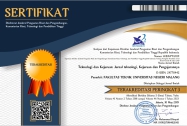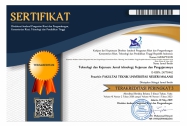Developing a Digital Learning Interactive 3D Exploded View Automobile Brake System
Abstract
This research aimed to design and develop an Exploded View 3D Model learning media on the brake system topic, as well as knowing the feasibility of learning media 3D Exploded View model on brake system topic. This study used the research and development method. The development model used the ADDIE, which consists of five stages: analysis, design, development, implementation, and evaluation. The subjects of the product trial were teachers and 11th-grade students in Public Vocational High School 11 Malang. Material experts and media experts carried out the product feasibility test phase. A media test was conducted on students. The data analysis technique used questionnaire and evaluation questions, as well as descriptive statistical analysis techniques. The results of this study were an Android-based learning media in the form of a 3D Exploded View model on brake system topic, and the results of the feasibility assessment by material experts got a percentage of 89.6 percent in the category of "feasible". The feasibility assessment by media experts received a percentage of 95.8 percent in the category of "feasible". The percentage obtained from small group trials was 85 percent with the category "feasible". The results of the student evaluation found that the average field trial score was 89. The conclusion of this research was the development of Android-based Learning media on the brake system topic is declared feasible to be used in the learning process.
Keywords
Full Text:
PDFReferences
Misbah, M., W. A. Pratama, S. Hartini, & D. Dewantara. PSEJ. Pengembangan e-learning berbasis schoology pada materi impuls dan momentum untuk melatihkan literasi digital. 3(2), 109-114. 2018.1
Kustandi & Sutjipto. 2011. Media Pembelajaran Manual Dan Digital. Bogor: Ghalia. Indonesia.2
A. Khumaidi, I. Sucahyo. JIPF. Pengembangan mobile pocket book fisika sebagai media pembelajaran berbasis android pada materi momentum dan impuls. 7(2). 154-158. 2018.3
B. S. K. Polonia, L. Yuliati. BIPF. Effectiveness of Mobile Learning: moPhyDict to Improve High School Students’ Physics Conceptual Understanding. 7(2). 115-122. 2019.4
H. Hasbiyati, D. Sudiarti. JPS. Pengembangan media ulangan harian berbasis aplikasi smartphone. 7(1). 8-13. 2019.5
Cangara, H. 2006. Pengantar Ilmu Komunikasi. Jakarta: PT Raja Grafindo Persada.6
Hardjana, A. M. 2003. Komunikasi intrapersonal & Komunikasi Interpersonal . Yogyakarta: Penerbit Kanisius.7
M. Nasir, R. B. Prastowo, Riwayani. JOES. Design and Development of Physics Learning Media of Three Dimensional Animation Using Blender Applications on Atomic Core material. 2(2). 23-32. 2018.8
Ally, M. 2009. Mobile learning: transforming the delivery of education and training. Québec: AU Press9
A. B. Retnomurti, N. Hendrawaty, L. Tiwiyanti. JOEE. Development Of Android-Based Protadroid Application In Pronunciation Practice Learning For Undergraduate Students. 7(2). 67-76. 2019.10
Abror ,I. Z. 2017. Pengembangan Media Pembelajaran Mobile Learning (M-Learning) Berbasis Android Untuk Siswa Kelas XI Pada Materi Struktur Dan Fungsi Organel Sel Di Man 3 Kota Banda Aceh. Aceh: UIN Aceh.11
Yuntoto, S. Pengembangan Aplikasi Android Sebagai Media Pembelajaran Kompetensi Pengoperasian Sistem Pengendali Elektronik Pada Siswa Kelas XI SMKN 2 Pengasih. Yogyakarta:UNY. 12
G.V.S.S. Sharma and M.V.A. R. Bahubalendruni. IJOPE. An Automated Computer Aided Procedure for Exploded View Generation. 13(4). 390-399. 2017.13
G. Wheeler, S. Dheng, N. Toussain, K. Pushparajah, J. A. Schnabel, J. M. Simpson, A. Gomez. HTL. Virtual interaction and visualisation of 3D medical imaging data with VTK and Unity. vol.5. 148-153. 2018.14
M. I. Ghazali, F. Samopa, N. A. Sani. JTI. Pengembangan Peta Interaktif Tiga Dimensi Gedung Rektorat Institut Teknologi Sepuluh Nopember Menggunakan Unity 3D Engine. vol 4. a113-a118. 2015.15
Sugiyono. 2011. Metode Penelitian Kuantitatif, Kualitatif, Dan R & D. Bandung: Alfabeta.16
Branch, R. M. 2009. Instructional Design: The ADDIE Approach. USA: University of Georgia.17
DOI: http://dx.doi.org/10.17977/um031v43i22020p124-129
Refbacks
- There are currently no refbacks.
Copyright (c) 2020 Teknologi dan Kejuruan: Jurnal Teknologi, Kejuruan, dan Pengajarannya
Teknologi dan Kejuruan: Jurnal Teknologi, Kejuruan, dan Pengajarannya
E-ISSN 2477-0442 (online)
Contact
Faculty of Engineering, Universitas Negeri Malang (UM)
Jl. Semarang No 5 Malang 65145, Building H5, 1st Floor.
Homepage: http://journal2.um.ac.id/index.php/teknologi-kejuruan
Email: teknologikejuruan.ft@um.ac.id

This work is licensed under a Creative Commons Attribution 4.0 International License.



2.png)
1.png)
1.png)
1.png)
4.png)
1.png)
.png)

3.png)
1.png)
1.png)


